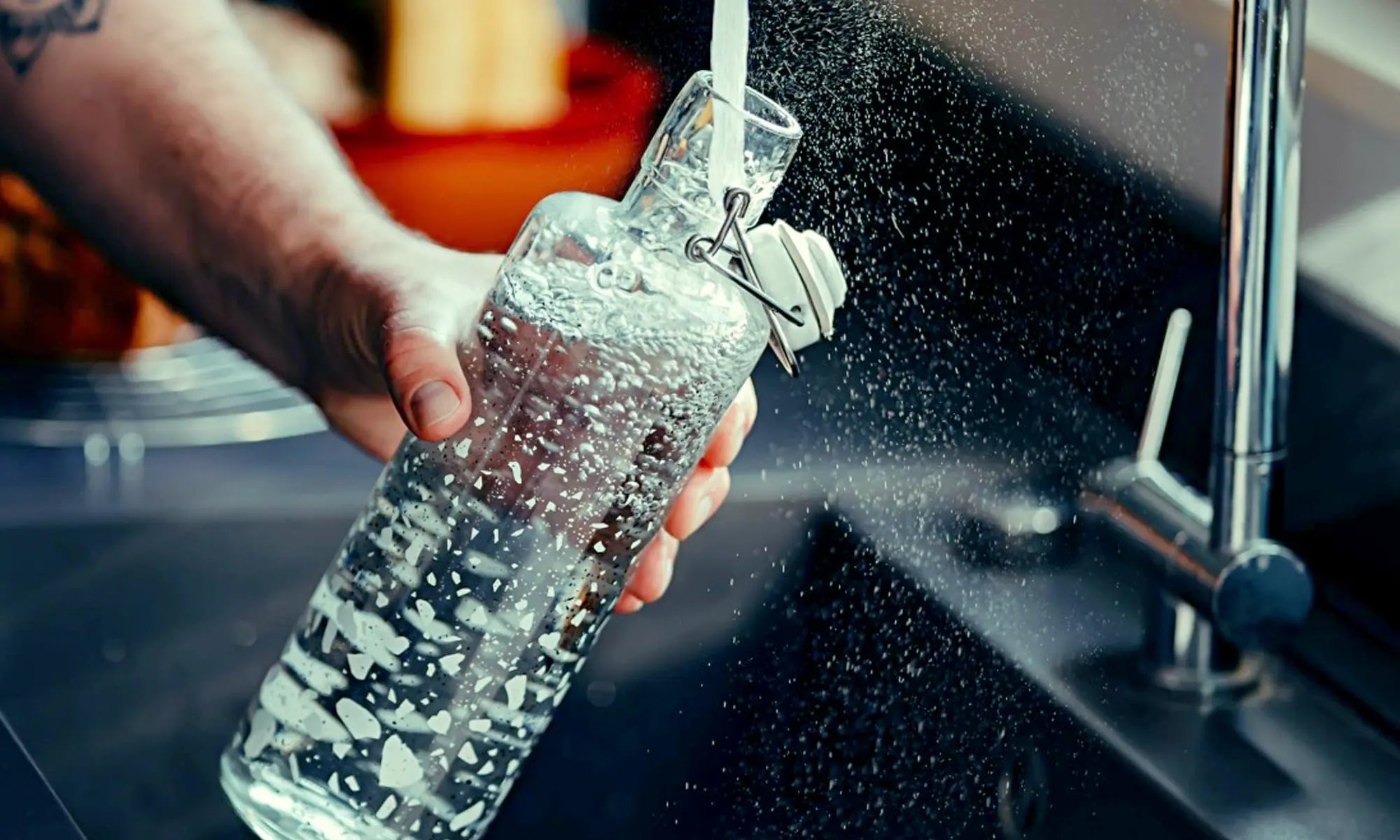Tap water is a great thirst quencher. Instantly available, inexpensive, and packaging-free—there has to be a catch somewhere, right? Don't worry, in the following blog post, we'll address your questions and explain the truth behind the common myths surrounding tap water. Let's get started!
Tap water doesn’t contain any minerals – or does it?
Mineral water = contains minerals. Tap water = not really?
As the name suggests, mineral water contains some minerals. However, there is no legal minimum content, which is why different products have different mineral concentrations and can therefore still be low in minerals. It is a widespread myth that tap water does not contain minerals: Potassium, magnesium, calcium and sodium are part of the standard repertoire of water. The amount of minerals dissolved in tap water varies greatly from region to region, as it depends on the geological composition of the soil. Watch out, this is where it gets exciting! Around two-thirds of tap water in Germany is extracted from—well, who would have guessed it?—groundwater. When it rains, most of the rainwater seeps into the ground and flows through several Soil and rock layers. In these layers, the water is enriched with the minerals present there before it reaches the groundwater. Aha! If you want to know exactly which minerals are in your tap water, check your water company's website.
But it doesn't really matter, because consuming (mineral) water isn't enough to meet your needs anyway. So: Better to eat a plate of vegetables or a slice of whole-grain bread than buy expensive water ;)
But what about lead in tap water?
The story of lead pipes is much bigger than the actual problem: At the end of the 19th and beginning of the 20th century, lead pipes were mainly installed in houses. In parts of southern Germany, Installation of lead-containing pipes was banned as early as 1878 , in the rest of the Republic in the 1970s of the last century. In Germany, a Limit value of max. 0.010 mg/l for lead in drinking water. Lead pipes (and thus lead-containing tap water) are present only in some older buildings built before 1973. Since Since 2013, homeowners and apartment owners are obliged to replace lead pipes as soon as the above-mentioned limit can no longer be met . Good to know!
If you're unsure when the water pipes were installed, it's best to ask the property management or test it yourself: Lead pipes appear silver-gray and are easy to cut with a knife because they are softer than copper and steel pipes. To be on the safe side (especially with older buildings and pipes), you can Take a water sample and send it to a laboratory. Otherwise, you can drink your tap water without worry.
What about drug residues and hormones?
Human life impacts nature and thus also water. This is often a problem, and therefore we all must contribute to protecting our water resources. This includes the handling of pharmaceuticals and hormone-like substances. But what is the difference between hormones, hormone-like substances, and pharmaceuticals?
Hormones are chemical messengers What about hormones? They regulate bodily functions such as growth, metabolism, sexual behavior, and much more. Over 50 hormones have been identified in humans.
Endocrine disruptors (colloquially environmental hormone Endocrine disruptors: These accumulate in the air, soil, and water. They have a hormone-like effect and can influence the function of the human organism instead of a natural hormone. The hormone-like effect of synthetic substances is usually only recognized when disturbances become apparent. However, endocrine disruptors also include natural hormones released into the environment by humans or animals (for example, via wastewater treatment plants). Medicines, on the other hand, are biologically highly active substances
Research projects show that pharmaceutical residues have indeed been detected in the environment and therefore also traces of them in groundwater and drinking water. However, quantities are extremely small and the World Health Organization (WHO) does not consider this to be a cause for concern not harmful for drinking water consumption How can that be, you might ask? Here's a small example calculation:
Among other things, the painkiller diclofenac has been detected in surface water. The average dose measured in Germany is 0.6 micrograms per liter, which corresponds to 0.0000006 grams. For comparison: a lower-dose tablet contains 0.025 grams of diclofenac. There is no data yet on how much of this is ultimately contained in drinking water, but the value is very likely much lower. Based on the surface water value, you would have to drink almost 42,000 liters of water to absorb the dose of a single tablet . With a daily drinking amount of 2 l over 57 years and thus a super low load ! The limits for tap water are so low that people no health damage with daily consumption can suffer from it. The limits for many foods are set much higher, as legislators assume that these foods are not consumed in as high quantities every day as tap water.
Nevertheless, the following applies: Do not dispose of medicines down the toilet ! Expired or no longer used medications (including birth control pills) should best be disposed of with the residual waste or taken to a pharmacy, as they otherwise enter our water cycle.
Hormone-active substances in water also affect bottled mineral water For example, the estrogen levels in mineral water from plastic bottles alone are twice as high as those from glass bottles. Researchers suspect this is due to chemicals or plastic additives that can be released into the water from the plastic bottle.
and germs in tap water?
Germs and their proliferation are mainly caused by older, less heavily used piping systems or in long-term stagnant water. Stagnant water Stagnant water occurs when tap water is left standing in the pipes for several hours or days without flow. This can lead to the growth of germs (depending on the temperature). However, in cold water pipes, where the temperature is usually below 20°C, germ growth is generally minimal, except during very long periods of stagnation.
Therefore, always diligently Drain stagnant water , if you want to tap fresh tap water in the morning! You can recognize fresh tap water by the fact that the water is noticeably fresher and regularly cold. Usually, it is sufficient if you are not away for a long time. Drain for 15 seconds or 1 liter of water If you want, collect the water in a watering can and use it to delight your flowers in your house and garden—they'll be delighted!
Welcome to the tap water nerd team!
So, now you're well informed about tap water! Currently, tap water is safe, but we live in an ever-changing world. For example, the population is aging, and thus the consumption of medications that can enter our water system is increasing. On the other hand, we must better protect our water and ensure that it remains protected by regulations!
If you're still unsure about your water, you can test it (especially with regard to the pipes) as described above. Otherwise, you can always filter the water again if you feel more confident doing so. This also applies, of course, if you simply prefer filtered tap water! For this, we offer our in-bottle water filter "soulfilter," which will accompany you not only in everyday life but also on your next summer vacation, saving you from plastic bottles.
Bottled water offers no alternative , especially in comparison to CO 2 emissions: Just by switching to tap water you reduce your CO₂ consumption from 148 kg CO₂ to 0.26 kg per year . Aside from that Tap water also saves money , what more could you want?
And because drinking from a fresh bottle is so much more fun, you can find our soulbottles drinking bottles with over 30 different designs here. New to the souliverse? You can find all products here.
cheers to the planet!
Sources and further information:
https://www.quarks.de/gesundheit/ernaehrung/3-prejudicial-against-leitungswasser/
https://www.wassertest-online.de/blog/mineralstoffe-im-leitungswasser-wird-der-koerper-durch-wasser-aus-dem-hahn-ausreichend-versorge/
https://www.hausjournal.net/die-fähren-von-stagnationswasser
https://www.umweltbundesamt.de/daten/chemikalien/arzneimittelrueckstaende-in-der-umwelt#arzneimittelwirkstoffe-in-der-umwelt






